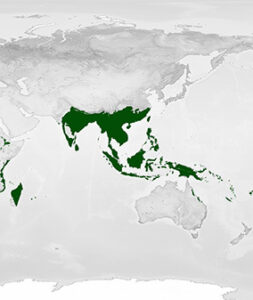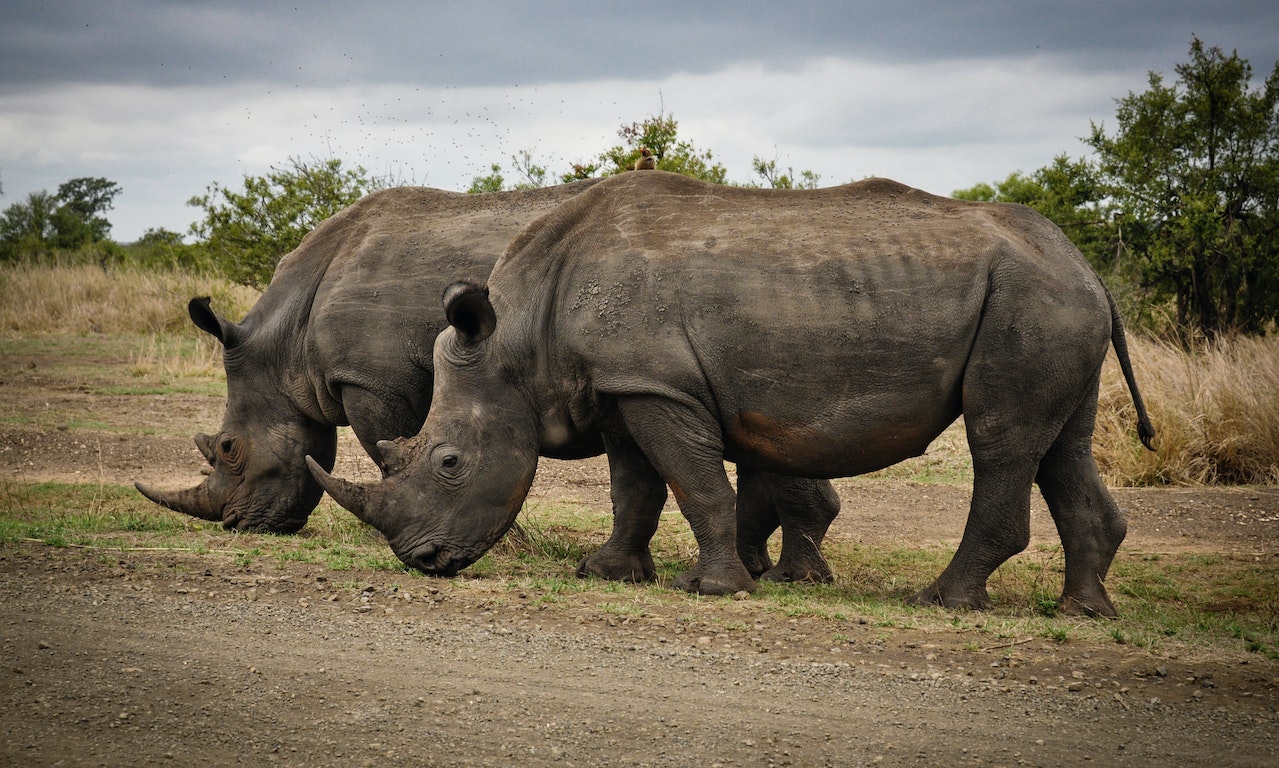

Life around the world
Different types of terrestrial ecosystems provide distinct habitats for various species, each adapted to the specific conditions of that habitat. For example, forests provide a habitat for tree-dwelling organisms, while deserts support specialized plants and animals adapted to arid conditions.
Wildlife refers to all living organisms that are not domesticated and exist in their natural habitats. It encompasses a diverse range of species, including animals, birds, plants, fungi, and microorganisms, that thrive in various ecosystems across the planet. Wildlife can be found in forests, grasslands, wetlands, deserts, oceans, and even urban areas.
Earth has 71% ocean
and 29% land (149 million square km)
Approximately 5.5 % of the Earth’s total land area is The tundra (8 million square kilometers)
Approximately 10.4% is Boreal forest. (15 to 16 million square kilometers)
Approximately 5.37% are Temperate deciduous forests (7 to 9 million square kilometers)
Approximately 5.03% is Tropical rainforest (roughly 7 to 8 million square kilometers)
Approximately 23.48% Grasslands (roughly 30 to 40 million square kilometers)
Approximately 22.81% is Desert (roughly 34 million square kilometers)
It’s important to note that the extent of terrestrial ecosystems can vary due to factors such as climate change, natural fluctuations, and human impacts.
Approximately 71% of this land is habitable land (106 million square km)
Approximately 46% of habitable land is used for Argiculture (48 million square km)
Approximately 38% of habitable land is forest (40 milion square km)

Cold habitats
The Tundra
Boreal Forest
Trend of habitat
- Global ice sheets are melting at a rate of 424 billion metric tonnes per year.
- Antarctica is losing a staggering 147.0 billion metric tons of ice mass annually.
- Arctic sea ice is shrinking at a rapid rate of 12.6% per decade.
- Greenland is experiencing more rapid ice sheet loss compared to Antarctica.
- The ice loss from Greenland amounts to 271 billion metric tons every year.
- Glaciers in the reference network are losing approximately 1.2 meters (3.9 feet) of water equivalent per year, as revealed by annual reports.
- Permafrost is emitting 0.3 to 0.6 billion metric tons of carbon per year.
The ecosystems within the North American Arctic-Boreal Zone (ABZ) undergo a wide range of disruptions linked to factors such as wildfires, permafrost changes, natural landscape shifts, insect infestations, disease outbreaks, extreme weather occurrences, and human actions. The ABZ is warming more than twice as fast as the global average, leading to an accelerated rise in the scale, occurrence, and intensity of these disturbances.
The Tundra
The Tundra is found in the northernmost parts of the world, predominantly in the Arctic regions, but there are also alpine tundras in high mountain ranges around the globe. The tundra is one of the harshest and most challenging environments for life due to its extreme conditions, including cold temperatures, permafrost, and a lack of trees.
Rising temperatures can cause permafrost to thaw, altering the ecosystem dynamics. Additionally, increased human activity in the form of resource extraction, tourism, and infrastructure development can disturb tundra ecosystems.
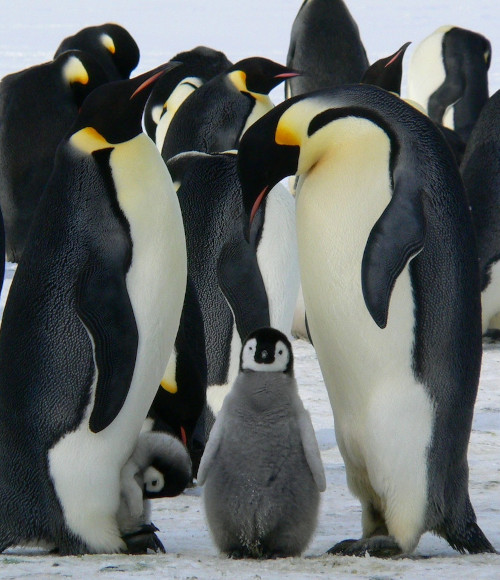
Tundras are characterized by low-growing vegetation, including grasses, mosses, lichens, and small shrubs. Permafrost restricts the growth of plants with deep root systems because the frozen ground prevents the growth of roots deeper into the soil. While tundras might seem barren, they have a unique biodiversity adapted to the extreme conditions. These include mammals like reindeer (caribou), musk oxen, arctic foxes, and polar bears.
Endangered Wild life
Pacific Walrus
As sea ice retreats at an alarming rate in the Arctic region, these walruses find their essential resting and hunting platforms diminishing. With ice serving as a crucial platform for resting, birthing, and nursing their young, the reduction in ice cover forces these animals to travel greater distances in search of suitable areas. This increased journey comes with higher energy demands and risks.
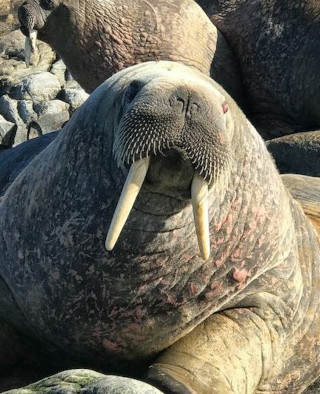

Polar bear
As the Arctic ice continues to shrink due to warming temperatures, polar bears are facing a substantial reduction in their primary hunting grounds and resting platforms. The sea ice serves as a vital platform for hunting seals, their main food source, and for traveling across vast expanses. With less ice available, polar bears are forced to cover greater distances to find food and suitable areas, leading to increased energy expenditure and challenges in finding sustenance.
Arctic fox
This fox relies on snowy landscapes and tundra for shelter, food, and raising its young. However, as snow cover decreases and plant life alters due to warming conditions, the fox’s ability to find prey and camouflage becomes more challenging. Climate change is extending the range of red foxes (the treeline is moving further north as the tundra retreats) Red foxes are twice the size of Arctic foxes and not only compete for prey but can take their dens by killing or chasing them away.
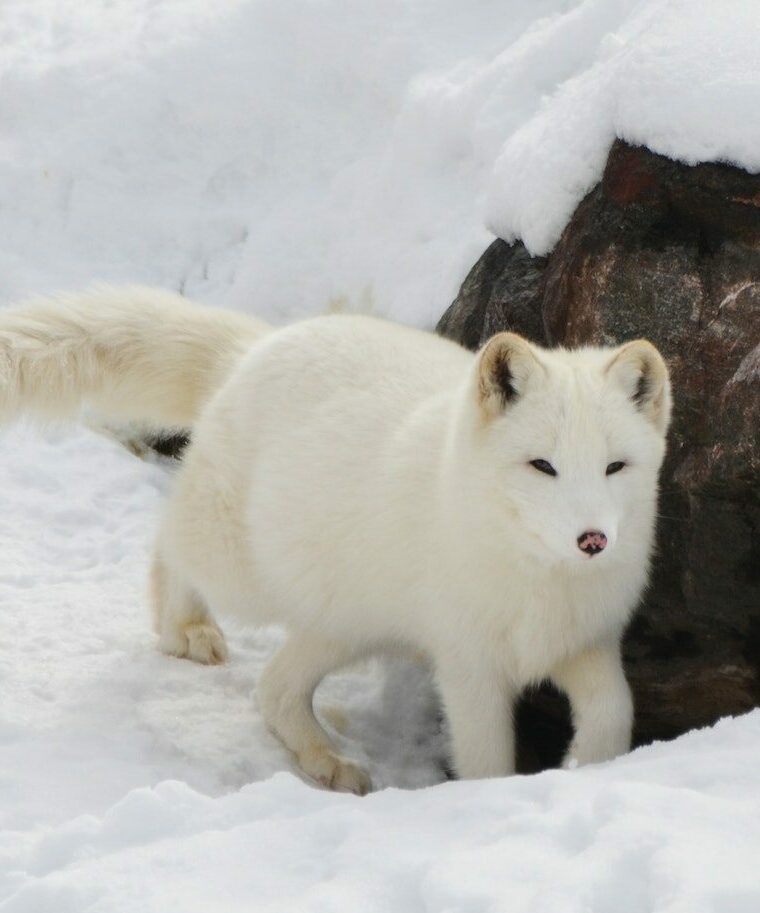

Reindeer
The reindeer rely on vast tundra landscapes for grazing migrating and shelter. But as warmer temperatures alter the vegetation and permafrost, their habitat becomes less suitable. Reindeer numbers have fallen by more than half in the past two decades. They survive by migrating to find food in the snow. But climate change means herds must swim across previously frozen rivers and many young calves drown. Rising temperatures mean more rain, covering plants with ice instead of snow, making grazing harder. Additionally, industrial development like forest logging and mining projects in the Tundra region encroach on their living spaces.
The Red List encompasses a multitude of magnificent animals facing harsh conditions due to climate change. The animals highlighted on our website are intended to provide a general overview, rather than being more threatened than other species on the endangered species list in their respective regions.
Boreal Forest
Boreal forest, also known as Tiaga or snow forest, is characterized by vast expanses of trees, cold temperatures, and short summers. It is one of the largest terrestrial biomes on Earth, stretching across northern regions of North America, Europe, and Asia. The taiga is found just south of the Arctic tundra and is known for its distinctive ecological features.
The Boreal forest has been influenced by human activities such as logging, mining, and oil extraction. The taiga plays a significant role in global carbon storage. The trees and soil in this biome hold substantial amounts of carbon, which can have implications for climate change if disturbed.
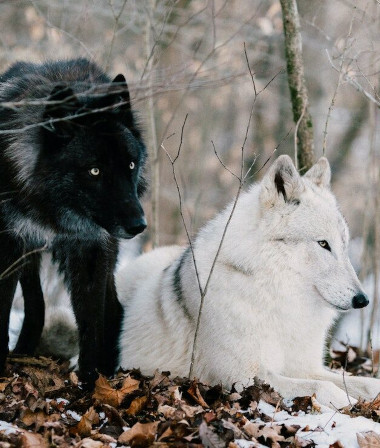
These trees are well-adapted to the cold climate and have needle-like leaves that help them conserve water and withstand the weight of snow. The soil in the taiga is often acidic and nutrient-poor due to the slow decomposition of organic matter in cold conditions. Species like moose, reindeer (caribou), wolves, lynx, and various bird species can be found in this biome. Many animals have special adaptations, such as thick fur and hibernation, to survive the winter months.
Endangered Wild life
Siberian tiger
The Siberian tiger is endangered due to habitat loss, poaching, and human-wildlife conflict. As the largest tiger sub-species, it’s a keystone species, playing a vital role in regulating prey populations. Operating as apex predators, Siberian tigers contribute significantly by regulating prey populations. Their range once spanned the taiga and boreal forests, China, and the Korean peninsula, but has significantly shrunk. The Amur tiger population is estimated at around 500 individuals.
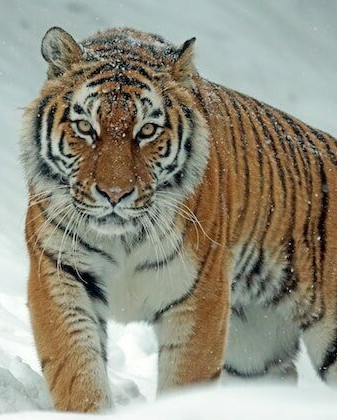
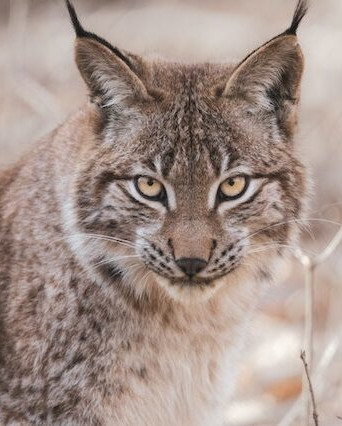
Canadian Lynx
The Canadian lynx is a medium-sized wildcat that inhabits North America’s boreal and mixed forests. Identified by its distinctive tufted ears and thick fur, this elusive predator primarily preys on snowshoe hares, which constitute a substantial portion of its diet. The population of the Canadian lynx experiences cyclical fluctuations that correlate with the abundance of its primary prey. Climate change, habitat alteration, and resource extraction impact its habitat and availability of prey.
Brown Bear
As their habitats diminish due to deforestation, urbanization, and industrial expansion, brown bears face reduced areas for shelter and foraging. Brown bears play important roles as predators who keep other animal populations in check and act as seed dispersers, contributing to the health of their environment. Encounters with humans lead to conflicts over resources, exacerbating bear deaths. Bear gall bladders bring high prices as traditional medicines on the Asian market, although there is no evidence to support their medical value.
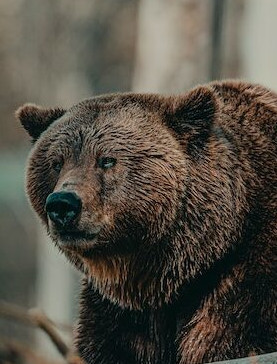
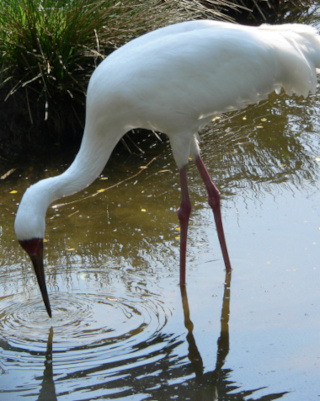
Siberian Crane
The Siberian crane is a critically endangered bird species that breeds in the vast wetlands of Siberia and Central Asia and migrates to warmer regions during the winter. Known for its elegant white plumage and distinctive red face patch, this crane species faces severe threats to its survival. Habitat loss, degradation of wetlands due to drainage and human development, and disruption during migration routes contribute to its critical status. Conservation efforts focus on preserving crucial breeding and stopover sites, as well as addressing the challenges posed by human activities along its migratory path.

Forest Habitats
Temperate deciduous forests
Rainforests
Trend of Habitat
Photosynthesis creates oxygen
Rainforests contribute significantly to our oxygen supply, generating about 28%—approximately one-third—through their photosynthesis process. Photosynthesis is a wonderful process: sunlight + water + CO2 = oxygen (O2) and sugar (glucose). It occurs only during daylight with sunlight and produces clean air and energy—a true marvel of nature.
Carbon sink extract carbon dioxide (CO2) from the air
Plants, trees, grasslands and wetlands absorb carbon dioxide (CO2) from the atmosphere during photosynthesis. The carbon from CO2 gets incorporated into these plant tissues. During decomposition, some of the carbon is incorporated into the soil. Organic matter that accumulates on the forest floor, known as litter, and partially decomposed organic matter, known as humus, also store carbon. These materials act as reservoirs for carbon, slowing down the release of CO2 back into the atmosphere. Peatlands and wetlands are particularly effective carbon storage areas. These waterlogged environments slow down the decomposition process due to limited oxygen availability. As a result, dead plant material accumulates over time, forming layers of peat that store large amounts of carbon.
Deforestation main driver
Nearly 46% of the ice-free surface of the Earth is dedicated to agricultural land. As the global population continues to grow, the demand for land is projected to increase, which will exert additional stress on delicate tropical forests and grasslands. In regions like South America, the expansion of cattle ranches and soy fields is causing extensive damage not only to the Amazon but also to the Cerrado and Gran Chaco landscapes.
Deforestation drivers
Deforestation is driven by a complex interplay of factors, including agricultural expansion, logging for timber, urban development, infrastructure projects, and mining. Economic incentives, population growth, and inadequate land-use planning contribute to this alarming trend. Moreover, illegal logging and weak law enforcement exacerbate the issue, posing significant challenges to global biodiversity, climate stability, and local communities that rely on forests.
Deforestation global rate
Every year, around 18.7 million acres of forests are lost to deforestation and degradation, primarily in tropical regions. This rate equals the destruction of 27 soccer fields every minute. The reasons vary—some areas are cleared for ranching and agriculture, while others are unlawfully logged for timber. Regardless of the cause, the impact of this loss and degradation on forests is uniformly distressing.
Deforestation rate of Amazon rainforest
Approximately 20% of the Amazon rainforest has vanished in the last 50 years. On a positive note, 50 years ago, there were merely two national parks in Venezuela, alongside a national forest and an indigenous reserve in Brazil. Presently, over 50% of the Amazon enjoys some form of protection. In the global carbon cycle, tropical forests act as a significant carbon sink, accounting for roughly half of the atmospheric carbon. The Amazon alone holds about half of this carbon. Thus, losing the Amazon would significantly amplify climate change. São Paulo is currently experiencing a severe drought, potentially its worst, partially due to reduced Amazon rainfall.
Temperate deciduous forests
These forests are found in regions with moderate climates that have four distinct seasons: spring, summer, fall, and winter. They are common in parts of North America, Europe, and Asia.
Forests have been impacted by human activities, including urbanization, agriculture, and logging. Temperate deciduous forests are important ecological zones with a diverse array of flora and fauna. They are also valuable for human enjoyment, and their contributions to the health of the planet’s ecosystems.
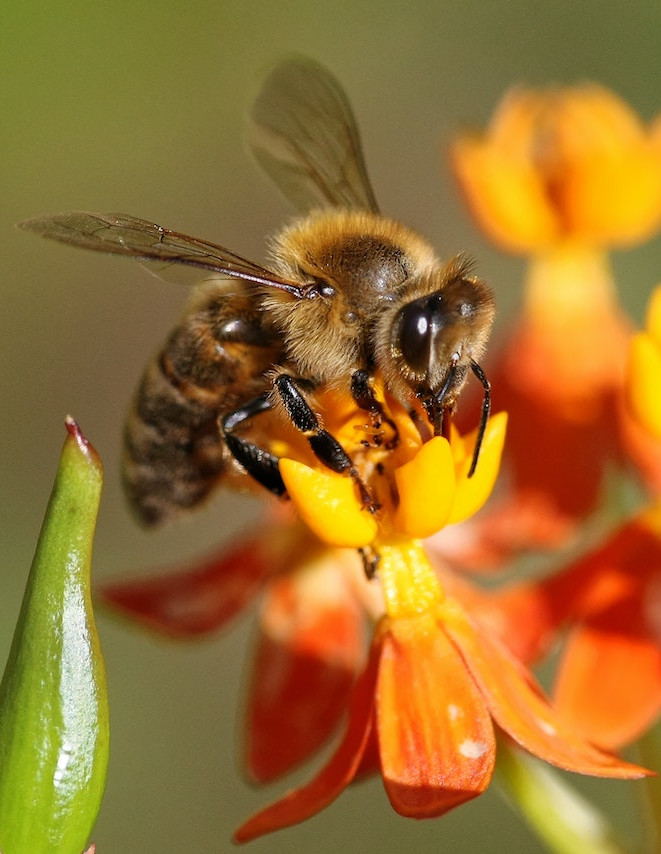
One of the defining features of temperate deciduous forests is the dominance of deciduous trees, which lose their leaves in the fall as a strategy to conserve water and energy during the cold winter months. Common tree species include oak, maple, beech, birch, and hickory. This leaf litter serves as a nutrient source for the soil as it decomposes over time. The diverse plant life in these forests supports a variety of wildlife, including deer, squirrels, rabbits, foxes, birds, and insects. Many animals have adaptations that help them survive the cold winter months, such as hibernation, migration, or changing fur colors.
Endangered Wild life
Eastern box turtle
These turtles have the ability to navigate across considerable distances and return to their original home range, even when released far from it. These turtles, characterized by their domed shells and vibrant markings, play a crucial role in maintaining forest ecosystems by aiding in seed dispersal and controlling insect populations. However, their survival is threatened by habitat loss resulting from urban expansion and road development. As they navigate forest floors in search of food and shelter, they often encounter hazardous roads, leading to high mortality rates.
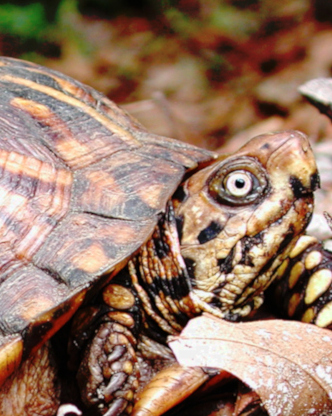

Red-cockaded woodpecker
This woodpecker is a bird species that depends on the unique habitats provided by mature pine forests. Recognized for its striking black-and-white plumage and the small red streak on males’ heads, this woodpecker plays a vital role in temperate deciduous forests. However, their populations have been declining due to habitat loss caused by logging and forest fragmentation. They excavate cavities in living pine trees, which not only serve as their nesting sites but also provide essential shelter for other wildlife. Conservation efforts are crucial to preserving these specialized habitats and ensuring the survival of this remarkable woodpecker species.
Indiana bat
The Indiana bat resides in temperate deciduous forests and is known for its unique behaviors and vulnerabilities. These bats undertake long migrations, traveling hundreds of miles between summer roosting areas and winter hibernation sites. Unfortunately, their survival is threatened by habitat loss, disturbance during hibernation, and a deadly fungal disease called white-nose syndrome. This disease has led to significant declines in their populations. Indiana bats play a critical role in controlling insect populations, contributing to forest health and agriculture. Conservation efforts are essential to protect their habitats, mitigate disease impacts, and ensure the preservation of these remarkable flying mammals.
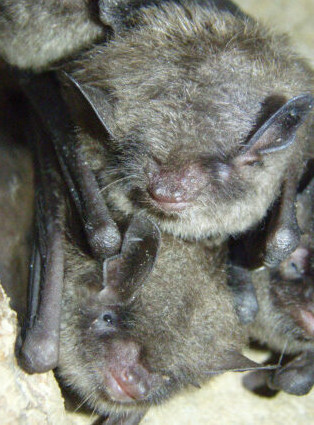
Tropical rainforests
Tropical rainforests have a hot and humid climate year-round, with temperatures often ranging between 70°F (21°C) and 90°F (32°C). They receive abundant rainfall, usually more than 100 inches (250 cm) per year, often in the form of daily rain showers. Tropical rainforests cover only about 6% of the Earth’s land surface, but they contain more than half of all known species.
Tropical rainforests are under significant threat from activities such as deforestation, logging, agriculture, and mining. Human activities have led to habitat loss, which endangers numerous plant and animal species.
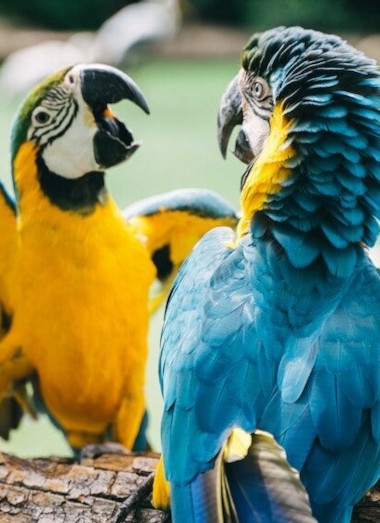
Tropical rainforests have distinct layers or strata of vegetation, including the emergent layer (tallest trees), canopy layer (dense network of tree crowns), understory layer (smaller trees and shrubs), and forest floor (limited sunlight due to the dense vegetation above). Animals in tropical rainforests have evolved various adaptations for living in this environment. Birds, for instance, often have bright plumage and distinctive calls to communicate in the dense vegetation. Many animals are also adapted for life in the trees, including monkeys, sloths, and tree-dwelling reptiles.
Indigenous peoples have inhabited tropical rainforests for generations and have developed intricate relationships with the environment, using its resources sustainably. Tropical rainforests provide a range of ecosystem services, including carbon storage, oxygen production, climate regulation, and the provision of valuable resources such as timber, medicinal plants, and food.
The Amazon Rainforest
The Amazon Rainforest, stretching across a vast expanse of 6.7 million km² in South America, stands as a vibrant and crucial ecosystem often referred to as the “Lungs of the Earth.” Remarkably, it contributes significantly to its own rainfall cycle. Moisture from the Atlantic Ocean fuels rain within the Amazon, where about three-quarters evaporate back into the atmosphere. This moisture then travels westward, transforming into rain near the Andes, sustaining the Amazon river system
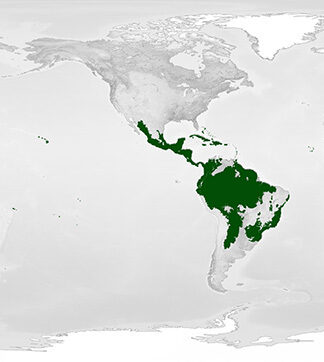
Hosting an astonishing array of plant and animal life alongside indigenous communities, the Amazon Rainforest spans 9 countries, including Bolivia, Brazil, Colombia, and others. This immense forest shelters over 350 ethnic groups, enveloping a staggering diversity of life: 40,000 plant species, 1,300 bird species, 2,200 fish species, 427 mammal types, 430 amphibians, and 380 reptile varieties. Moreover, it’s a realm of discovery, with a ‘new’ species of plant or animal emerging every three days on average, underscoring the Amazon’s unparalleled biodiversity
Endangered Wild life
Golden Lion Tamarin
The golden lion tamarin is a endangered primate native to the Atlantic Forest, a biome closely linked to the Amazon Rainforest. This tamarin plays an essential role in its ecosystem as a seed disperser, aiding in forest regeneration. Rising temperatures, altered rainfall patterns, and increased frequency of extreme weather events impact the tamarin’s habitat and food availability. The Atlantic Forest’s delicate balance is disrupted as the changing climate affects plant flowering and fruiting cycles, leading to potential mismatches between the tamarin’s reproductive timing and the availability of vital resources. Additionally, intensifies habitat fragmentation, further limiting the tamarin’s range.


Amazon River Dolphin
The Amazon River Dolphin, also known as the pink river dolphin, with its unique pink hue and playful behavior. This freshwater endangered dolphin holds ecological significance as an apex predator and indicator of river health. However, the Amazon River Dolphin faces severe threats due to habitat degradation, water pollution, and overfishing. Climate change compounds these challenges, altering river flow patterns, increasing water temperature, and impacting fish populations—the dolphins’ primary food source. These changes disrupt their habitats and exacerbate existing threats.
Congo Basin
The rainforest within the Congo Basin stands as Africa’s largest and second in size globally, only surpassed by the Amazon rainforest, encompassing a vast expanse of 300 million hectares (larger than Alaska). This wilderness area, spanning six countries including Cameroon, the DRC, and Gabon, holds immense significance. Often heralded for its role as a carbon sink, it’s crucial in mitigating climate change due to its size and diversity.
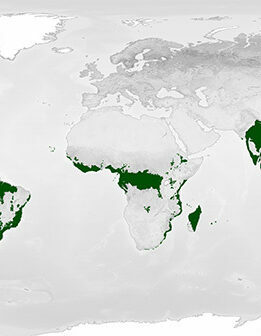
Teeming with life, this mosaic of rivers, forests, and savannas harbors treasures like the Congo River and a vibrant array of wildlife including gorillas, elephants, and buffalo. Approximately 10,000 tropical plant species, along with endangered creatures such as forest elephants, chimpanzees, and lowland and mountain gorillas. Housing 400 other mammal species, 1,000 bird species, and 700 fish species, it’s the sole haven for all three gorilla species—the lowland, the endangered mountain, and the endemic eastern lowland gorilla. This diverse basin has nourished human communities for over 50,000 years, providing sustenance, water, and shelter to over 75 million people. Among these, the Ba’Aka people stand as emblematic of ancient hunter-gatherer traditions, intimately tied to the forest that sustains them.
Endangered Wild life
Okapi
The okapi is a remarkable native to the dense and secretive jungles of the Congo Rainforest. Resembling a mix of giraffe and zebra stripes, the okapi boasts velvety dark brown fur contributing to their adaptation to life in the forest. Shifts in temperature and rainfall patterns directly impact the vegetation that the okapi rely on for food and cover, affecting their foraging habits and overall survival. Additionally, the presence of illegal armed groups around protected areas hinders conservation efforts and enables poaching, logging, mining, and encroachment. In a tragic incident in 2012, rebels attacked an Okapi reserve, resulting in the loss of both human lives and all captive Okapi.
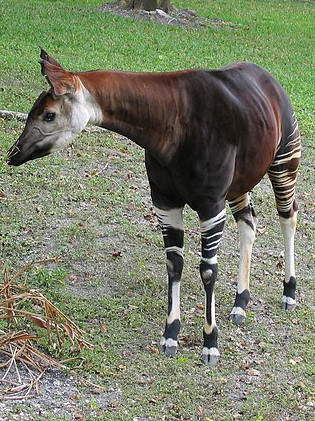
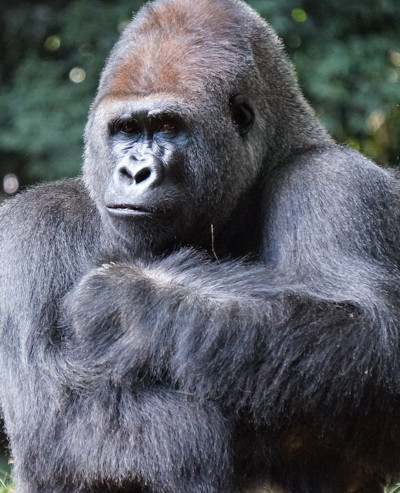
Gorilla
The western lowland gorilla is an endangered species that inhabits the lush depths of the Congo Rainforest. These gentle giants are characterized by their immense strength, intelligence, and complex social structures. Western Lowland Gorillas live in relatively close-knit family groups composed of around 10 individuals, on average, with one “silverback” adult male, several adult females, and their offspring. Unfortunately, the western lowland gorilla faces multiple threats, including habitat loss due to logging, mining, and agricultural expansion, as well as the impact of diseases like Ebola. Climate change alters their environment and exacerbates these existing challenges.
Borneo and Sumatra
Borneo and Sumatra, two captivating islands in Southeast Asia, harbor remarkable forests. Borneo’s rainforests sprawl across an area of about 287,000 square miles, making it the third-largest island in the world and shared among three countries: Malaysia, Indonesia, and Brunei. Sumatra, spanning around 182,000 square miles, lies west of the Indonesian archipelago. Its forests, a UNESCO World Heritage Site, are distinguished by their unique ecosystems, which provide a haven for endangered species.
These lush landscapes are crisscrossed by mighty rivers that serve as essential lifelines, facilitating transportation and meeting the freshwater needs of local communities. Remarkably, Sumatra hosts the exceptional coexistence of tigers, rhinos, orangutans, and elephants. Within these forests, captivating creatures like the proboscis monkey, sun bear, clouded leopard, and flying fox bat thrive, while endangered species like the Sumatran tiger, Sumatran rhino, and Bornean elephant find sanctuary. With over 15,000 known plant species and many awaiting discovery, Borneo and Sumatra remain centers of botanical marvels. Since 1995, more than 400 species have been identified here, with over 50 being entirely new to science, underscoring the islands’ ongoing contribution to our understanding of Earth’s biodiversity.
Endangered Wild life
Sun bear
The survival of Sun Bears in Borneo is imperiled by a constellation of formidable challenges, prominently deforestation and rampant commercial hunting. These bears, are central to the forest ecosystem, exerting a vital role in insect control and seed dispersal. The thriving trade in Sun Bear parts and an acute lack of enforcement of wildlife protection laws intensify the threat. The loss and fragmentation of forests—precipitated by extensive clear-cutting for plantations, unsustainable logging practices, and human-caused fires—severely compromise their habitat and food sources.
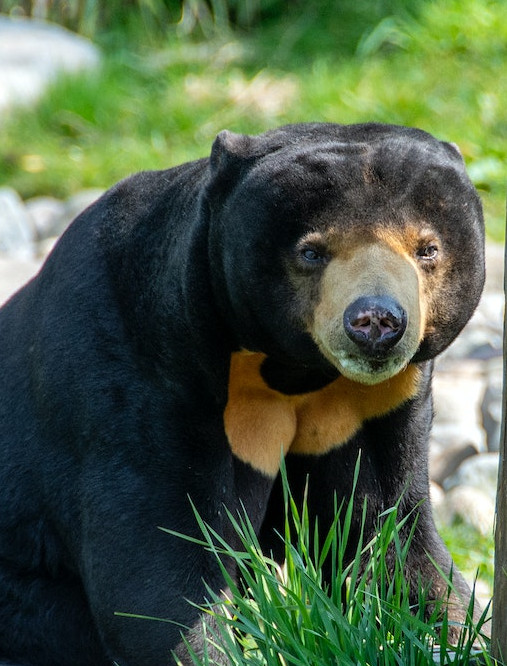
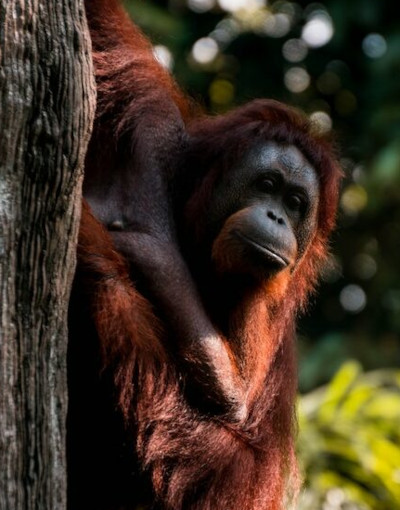
Orangutan
The survival of Sumatran Orangutans is in danger due to the loss and breakup of their homes (forest). Forests are being cleared for large oil-palm farms and smaller-scale logging, along with the creation of roads for illegal settlements, farming, and poaching. Orangutans are forced to move to smaller forest patches, where they face hunger and danger. They are also killed for illegal trading and during conflicts with humans. The biggest threat comes from a government-approved land-use plan that disregards protected areas for the Orangutans. Efforts are being made to change this plan and protect the Orangutans, but until then, their habitat continues to be destroyed, leading to more losses of these animals.

Water scarcity Habitats
Grasslands
Deserts
Trend in habitat
What is land degradation?
Land degradation refers to the deterioration of the quality and productivity of land due to various natural and human-induced factors. This degradation can take various forms, including soil erosion, loss of soil fertility, salinization, deforestation, desertification, and pollution.
What is desertification?
Desertification is a specific type of land degradation that occurs in arid, semi-arid, and dry sub-humid areas. It involves the loss of soil fertility, vegetation, and water resources, resulting in the expansion of deserts. Desertification refers to the process by which fertile land, becomes increasingly dry, barren, and unable to support vegetation and agricultural productivity. It is primarily caused by a combination of global warming, such as heat waves and drought, as well as human activities like deforestation, overgrazing, and poor land management practices. As a result of desertification, the land loses its capacity to hold water, its topsoil erodes, and biodiversity decreases.
What drives degradation?
As the Earth's temperature rises due to climate change and its population continues to grow, arable land is diminishing, primarily in dry regions where rainfall is scarce, such as deserts. Human activities such as inappropriate agricultural practices, deforestation, urbanization, and industrial activities can accelerate land degradation. As a result, the land becomes less capable of supporting healthy ecosystems, productive agriculture, and sustainable livelihoods.
Global land degradation rate
Roughly 25% of the world's land has already suffered degradation. This process releases soil carbon and nitrous oxide, significantly contributing to climate change. Alarming reports indicate an annual loss of 24 billion tons of fertile soil due to unsustainable farming. If unaddressed, this trajectory could result in 95% of Earth's land being degraded by 2050. This issue disproportionately affects 3.2 billion people, particularly rural populations, small-scale farmers, and the impoverished.
Of great concern is that over 75 percent of the world's land is already affected to some degree. To grasp the scale of this issue, imagine an area equivalent to half the size of the European Union (approximately 1.61 million square miles or 4.18 million square kilometers) becoming degraded annually, with Africa and Asia experiencing the most severe effects.
impact of desertification
Desertification is a pressing global issue affecting more than 100 countries, with its most severe impacts felt by the world's poorest and most vulnerable populations. Many of these regions rely on agriculture as a lifeline for sustenance. Desertification and land degradation also result in a range of health problems for both humans and wildlife:
- Malnutrition: Scarce food resources lead to malnutrition, weakening both people and animals.
- Respiratory Issues: Dusty air in desertified areas can cause respiratory diseases.
- Lack of Clean Water: Depletion of water sources and shortage of clean drinking water.
Most of Earth's grassland has been lost
Grasslands face peril from habitat loss, often driven by human activities like unsustainable farming methods, excessive grazing, and land clearance for crops. Nearly half of the temperate grasslands and 16% of tropical grasslands have been transformed for agricultural or industrial purposes. A mere one percent of the original tallgrass prairie remains today.
Degradation history
Historically, land degradation has been a gradual process. However, the current rate is alarming, estimated to be 30 to 35 times faster than historical rates. This accelerated degradation results from urbanization, deforestation, mining, intensive farming, and livestock raising. These activities strip the land of essential nutrients and deplete groundwater at unsustainable rates. Climate change exacerbates the problem, leading to more frequent droughts.
Grasslands
Temperate Grasslands: Such as prairies in North America or steppes in Eurasia. They experience cold winters and hot summers.
Tropical Savannas: A mix of grasses and scattered trees. They typically have wet and dry seasons.
Flooded Grasslands: These wetlands, with seasonal flooding, support unique plant and animal communities.
Many grasslands have been converted into agricultural fields for the cultivation of crops and grazing of livestock. The conversion of grasslands to farmland or urban areas has led to habitat loss and decreased biodiversity.
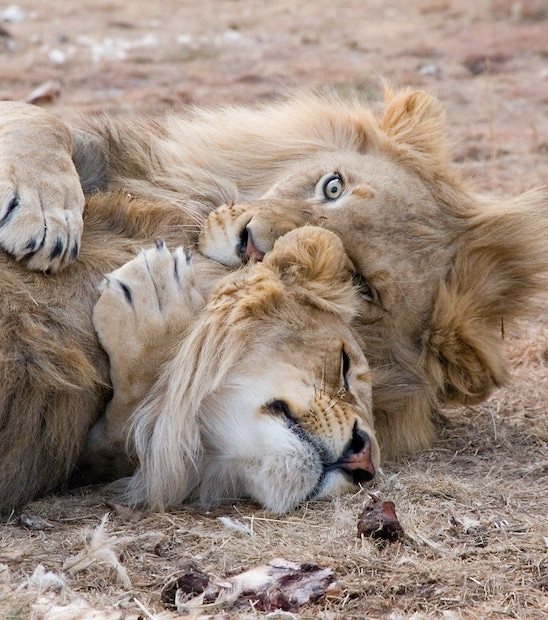
Grasslands, also known as prairies, savannas, steppes, or plains, are dominated by grasses, herbs, and other non-woody plants, with few to no trees. Grasses are adapted to fire, and periodic burning helps maintain the health of the grassland by preventing the encroachment of woody plants and recycling nutrients. Grasslands support a variety of animal species, including large herbivores like bison, wildebeests, and antelope. Predators like lions, cheetahs, and wolves often inhabit grasslands to hunt these herbivores.
Endangered Wild Life
Black Rhino
The Black Rhinoceros prefer savannas and areas with nutrient-rich soil, where they feed on acacia trees, palatable herbs, and succulent plants. The number of rhinos a habitat can support depends on factors like rainfall, soil nutrients, and fire history. Big plant-eating animals like elephants or giraffes in the same habitat eat similar types of vegetation as the Black Rhino. Competition for food among these herbivores affects how many Black Rhinos the area can support. Black Rhinos are in danger due to illegal hunting for their horns, which are sold on the illegal market. Most of the rhino horns in Asian markets come from this illegal trade. The horns have been used in Chinese medicine and for ornamental purposes. The rise in poaching has increased protection costs and risks for people working to save the rhinos.
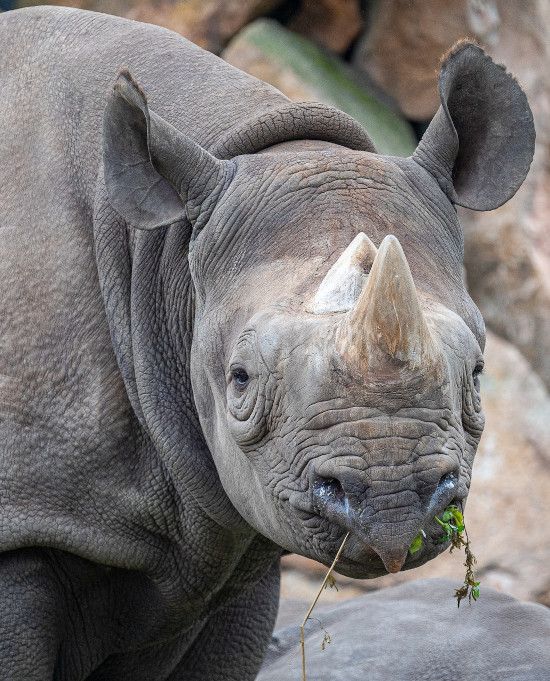
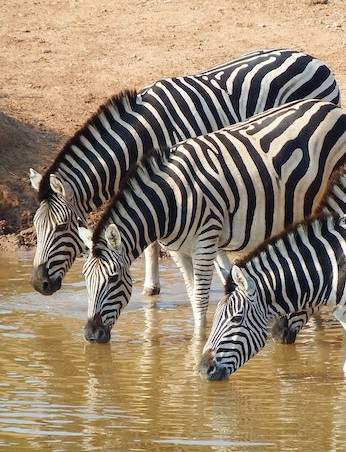
Zebra
One of the significant threats to Grevy’s Zebras is the scarcity and competition for water sources. Grevy’s Zebras have a more restricted range compared to other zebra species. Their habitat is limited to parts of eastern Africa, particularly in Kenya and Ethiopia. They live in arid and semi-arid grasslands that are often transformed by human activities like agriculture, settlements, and infrastructure development. Grevy’s Zebras often share their habitats with livestock like cattle and goats. These domestic animals can compete with zebras for resources such as water and food, especially at watering points.
Elephant
African Savanna Elephants face a significant threat from poaching for ivory, causing individual deaths and population declines. After a period of intense poaching from the late 1970s to 1989, some populations recovered, but others suffered ongoing poaching, especially in northern regions. Human-induced habitat changes, driven by population growth, agriculture, and infrastructure development, lead to habitat loss and fragmentation. This trend also triggers human-elephant conflicts. Land conversion is projected to escalate, exacerbating this threat. Urban sprawl, agriculture, commercial plantations, and tourism infrastructure contribute to habitat loss.
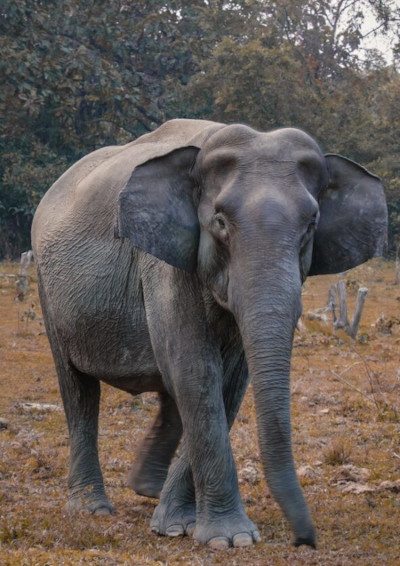
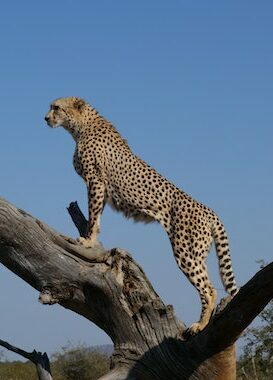
Cheetah
Cheetahs face critical challenges due to their need for large territories to hunt effectively. As human populations expand, habitats are transformed for farming and development, causing habitat loss and fragmentation. Prey scarcity can lead cheetahs to target livestock, resulting in conflicts. Hunting, both for sport and skin, threatens their survival. High-speed roads and infrastructure development cause fatalities and fragment habitats. Additionally, an illegal trade in cheetah cubs as pets exacerbates their decline.
Desert
Deserts cover about one-third of the Earth’s land surface and are found in various regions around the world. Deserts have very low precipitation levels, often receiving less than 250 millimeters (10 inches) of rainfall per year. Deserts can be extremely hot during the day and cold at night. Hot deserts include the Sahara Desert in Africa and the Arabian Desert in the Middle East. Found at higher latitudes and elevations, cold deserts experience colder temperatures and can receive some snowfall. The Gobi Desert in Asia and the Great Basin Desert in North America are examples.

Human activities such as urbanization, agriculture, and resource extraction can have significant impacts on desert ecosystems, leading to habitat destruction and desertification. Desert ecosystems are valuable components of the Earth’s natural landscape. Deserts play roles in soil formation, nutrient cycling, and geological processes. They also have cultural significance for indigenous peoples and support recreational activities like eco-tourism.
Some plants have reduced leaves to minimize water loss through transpiration, while others store water in their stems or leaves. Desert animals have evolved various strategies to survive in the harsh conditions. Many are nocturnal, becoming active during the cooler nighttime hours to avoid the heat. Some animals, such as camels, have specialized adaptations to store and conserve water.
Endangered Wild life
Addax
The Addax, a sizeable ungulate adapted to desert conditions, thrives in tough and arid landscapes. It’s distributed across various Sahara habitats, preferring compact sands and level spots with lasting vegetation amidst dunes and basins. Addax displays nomadic behavior, covering vast areas in search of sustenance. Unfortunately, uncontrolled hunting utilizing modern weaponry and vehicles has led to a severe decline in their populations. Droughts and expanded pastoral activities in deserts, supported by increased wells, have further exacerbated their plight. The presence of oil operations, military-related incidents, and conflicts add to the threats faced by the Addax.
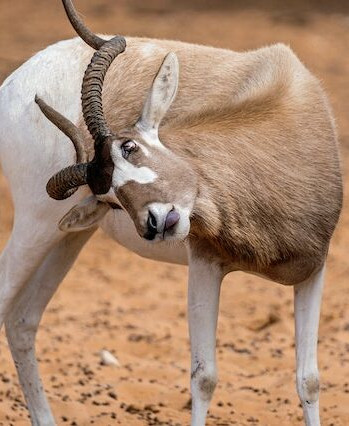
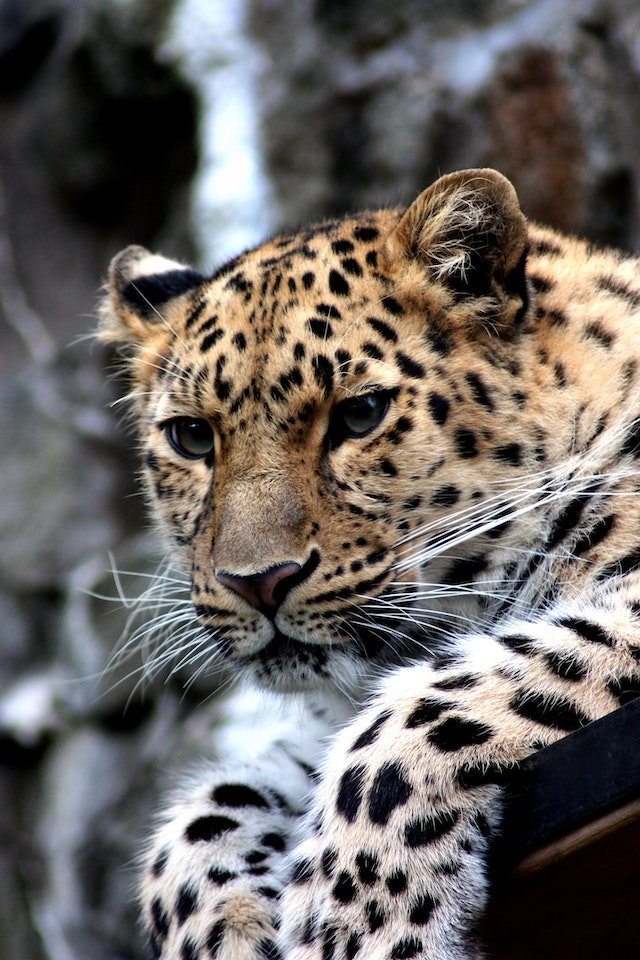
Leopards
Leopards are incredibly adaptable cats, found in a wide variety of habitats across their range. They can even thrive in desert and semi-desert regions in southern Africa. Their diet is versatile, ranging from insects and small animals to larger ungulates, and they can specialize in certain prey. However, their main threats come from human activities. Habitat fragmentation, reduced prey numbers, and conflicts with livestock and game farming have led to declining Leopard populations. Trophy hunting is also a problem, especially when not properly managed.
Snow Leopard
Snow Leopards face competition with livestock for resources such as grazing lands and prey. The conversion of habitat for livestock grazing and other human activities can contribute to habitat fragmentation and loss. Snow Leopards are targeted for their fur, bones, and other body parts, driven by demand in traditional medicine and the exotic pet trade. New threats, including climate change, mining, large-scale infrastructure development, and barriers like roads and fences, are emerging challenges that may impact Snow Leopards and their habitat.
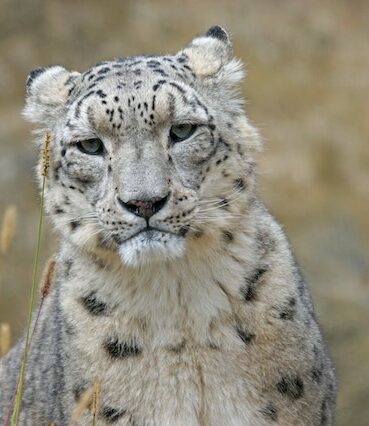
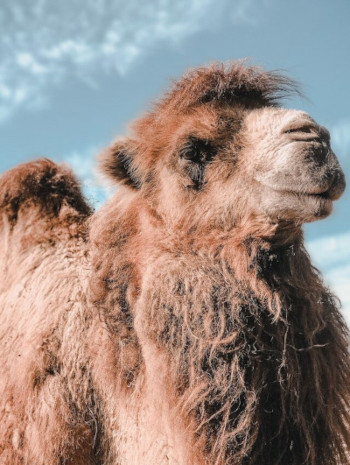
Camels
Bactrian Camels have distinctive features that help them survive in cold desert conditions. They have thick, shaggy fur that provides insulation against the cold temperatures. Bactrian Camels have been an integral part of the cultures and economies of the regions they inhabit. Their populations have declined due to factors such as habitat loss, hunting, and competition with livestock for resources. Oases, which are rare sources of water in desert environments, become focal points for various species to quench their thirst. However, droughts significantly reduce the availability of these water points. As water becomes scarcer, competition among different species, including predators and prey, intensifies around the remaining water sources.
Potential danger
- Release of carbon sink
- Less photosynthesis
- Poor air quality
- Risk for wildlife
- Migration of wildlife
- Unpredictable reactions of the Earth system
- Droughts, floods, or landslides
- Seasons that are unpredictable
- Extinction/decline of plants
- Extinction/ decline of wild life
- Extinction/decline of animals
- Extinction/decline of organisms
- Migration of people
- Migration of animals and organism
- Less clean water
- Wors weather conditions for agriculture
- Hunger and thirst
- Plagues of insects
- Pandemics
Solutions
By adopting comprehensive conservation strategies, we can mitigate the threats posed by deforestation, habitat loss, pollution, and land degradation. Implementing sustainable land management practices, reforestation, and habitat restoration initiatives are key actions to counterbalance these challenges.
Through collective dedication, we can secure the health and vitality of terrestrial ecosystems for current and future generations, preserving biodiversity, mitigating climate change, and nurturing thriving communities.
Sources and credits
your findings
The Future of Earth's Landscapes
Do you have insights into what the changing habitats will lead to? Will deserts expand or shift to higher or lower regions? Could places like Belgium experience a tropical transformation? We'd love to hear your thoughts on the future of our changing landscapes.

